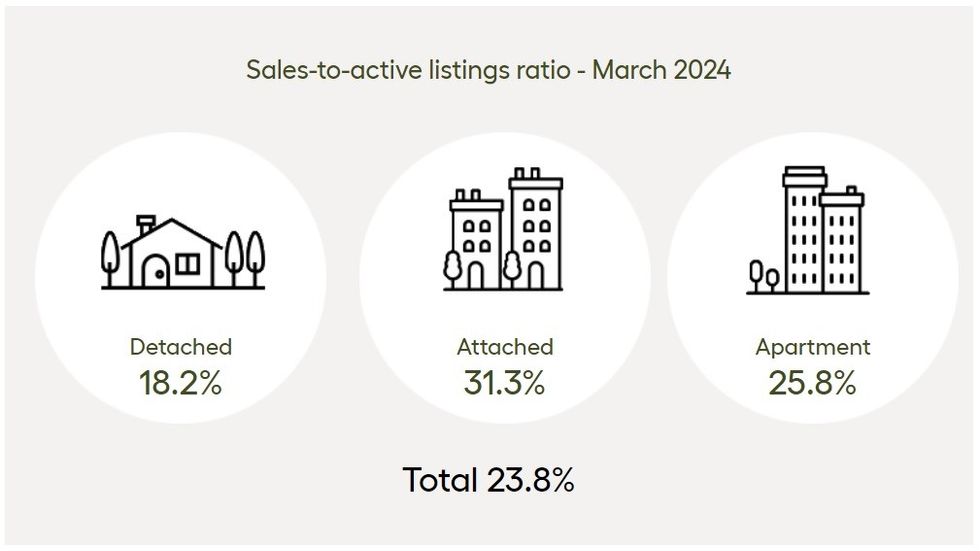Sellers are looking to sell, but market conditions are keeping buyer activity relatively low, according to the latest statistics published by Greater Vancouver Realtors (formerly the Real Estate Board of Greater Vancouver) on Wednesday.
According to GVR, March recorded a total of 2,396 residential sales, after recording 2,055 in February. The March total, however, is about a 5% drop off from March 2023 and more than 30% below the 10-year March average of 3,512.
Meanwhile, the amount of new listings that were added in March was 5,002, which represents a 15.9% increase compared to the 4,317 new listings in March 2023, although this year's total is still 9.5% below the 10-year average of 5,524.
With those new listings, the amount of active listings in Greater Vancouver is now up to 10,076, which represents a 23% increase compared to March 2023 and more than 6.3% above the 10-year March average of 9,923.
"If you’re finding the weather a little chillier than last spring, you may find some comfort in knowing that the market isn't quite as hot as it was last spring either, particularly if you're a buyer," said GVR's Director of Economics and Data Analytics Andrew Lis.
Buyers or Sellers
Using the above statistics, we can identify the sales-to-new-listings ratio and sales-to-active-listings ratio, which are two quantitative indicators that give us a sense of whether the market is leaning in any particular direction — towards buyers or sellers.
For the sales-to-new-listings ratio, a ratio of 40% or lower is considered a buyers' market, a ratio of 55% or higher is considered a sellers' market, and anything in between is considered a balanced market.
With 2,396 home sales and 5,002 new listings recorded in March, the sales-to-new-listings ratio is now at 47.9%, after being at 45.1% at the end of February, signalling movement towards a sellers' market.
For the sales-to-active-listings ratio, a ratio of 12% or lower is viewed as favouring buyers, a ratio of 20% or higher is viewed as favouring sellers, and anything in between is viewed as a balanced market.
With 2,369 home sales and 10,076 total active listings in March, the sales-to-active-listings ratio is now 23.8%, after coming in at 22.4% in February — reaffirming that the market is seeing movement towards sellers.
As was the case in previous months, however, there is a bit more nuance when looking at different property types, as the sales-to-active-listings ratio is 31.3% and 25.8% — well in sellers' market territority — for attached homes and apartments.

Prices and Outlook
Following March, the composite residential benchmark price is now up to $1,196,800, which is an increase of 1.1% from February 2024 and an increase of 4.5% from March 2023.
By property type, the benchmark price is now $2,007,900 for single-family homes, $1,112,800 for attached homes, and $777,500 for apartments. All three represent small increases of between 0.9% and 1.8% when compared to February and increases of between 5.0% and 7.4% when compared to March 2023.
"Even though the market isn't quite as hot as it was last year, we're still seeing modest month-over-month price gains of 1% to 2% happening at the aggregate level, which is an interesting dynamic given that borrowing costs remain elevated," added Lis. "With the latest inflation numbers trending in the right direction, it remains likely that we'll see at least one or two modest cuts to the Bank of Canada’s policy rate in 2024, but even if these cuts come, they may not provide the boost to affordability many had been hoping for. As a result, we expect constrained borrowing power to remain a challenging headwind as we move into the summer months."
The Bank of Canada will be making its next policy rate announcement on Wednesday, April 10.





















